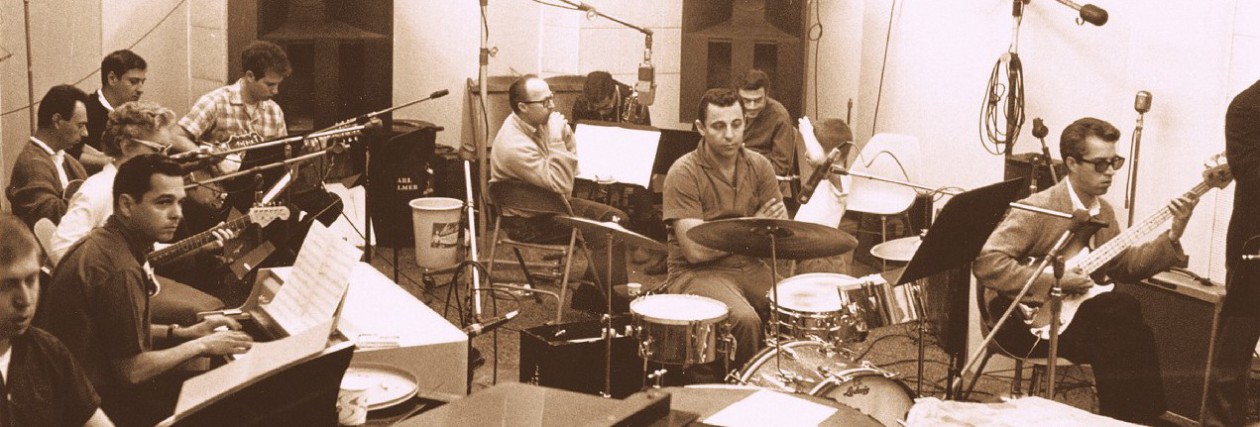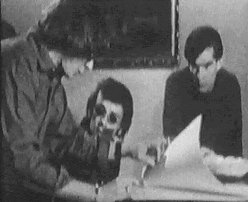What can I write about Jack ‘Specs’ Nitzsche that hasn’t already been chronicled elsewhere? A legendary songwriter, producer and artist in his own right, Nitzsche’s first major claim to fame was his arranging skills, expertly put to use on a string of iconic Spector productions.
When Spector relocated his recording activities from New York to Los Angeles, the then-emerging new Mecca for pop, Nitzsche was quickly enlisted as arranger for his first LA session in 1962, the recording of ‘He’s a Rebel.’
Spector not only got the most talented up-and-coming arranger in town at his side, he also gained access to Nitzsche’s invaluable contacts, bringing together a veritable ‘who’s who’ of LA’s best session musicians. These dynamic, versatile players were later dubbed the Wrecking Crew and proved ready, willing and able to help Spector experiment and challenge conventional recording practices. He had missed that kind of support in New York where session musicians often made a fuzz when the soon-to-be ‘Tycoon of Teen’ tried to coerce them into unorthodox session takes.

With Nitzsche as his right-hand man, Spector’s work took on gargantuan, cavernous proportions by each release. The duo worked together on so many classic recordings. The list goes on and on. I like this quote from legendary LA scenester Rodney Bingenheimer who visited the ‘River Deep, Mountain High’ session with Brian Wilson in 1966: “Jack and Phil were very tight. They were like co-pilots on the Concorde from a flight from France.” Well said!
Spector and Nitzsche really brought out the best in each other. As much as the Wall of Sound has often been attributed to the famed Gold Star studios echo chamber, you simply cannot underestimate Jack Nitzsche’s importance in the equation. Spector did create beautiful art with other arrangers, i.e. Arnold Goland, Gene Page and Perry Botkin Jr., but Nitzsche remained his preferred arranger – the one who understood his approach best. Always to be trusted to arrange those sweet, sweeping and highly beautiful strings that graced many a Philles release.
It is no surprise then that Nitzsche made the most out of his first-hand crash course in the Wall of Sound. There is a plethora of fantastic singles spread out among a myriad of labels. If a record company back then wanted a big sounding Wall of Sound production, hiring ‘Specs’ was your best bet. Not only did you get the master’s favorite arranger, you also got the same studio environment (Gold Star) and session musicians (the Wrecking Crew). More often than not, the results were prime examples of perfect Wall of Sound that could give even Spector a run for his money.

Labelling Nitzsche a mere Spector-clone though would be an insult. Unlike Spector, Nitzsche proved much more versatile and productive, moving with the times and amassing an impressive body of work through the 60s and beyond that proves he was well attuned to the shifting fads in the music business.
Where Spector often only hinted at the influence of, say, Motown or the emerging Folk-Rock sounds of the day, Nitzsche cleverly mixed his Wall of Sound background with the latest hot sound and got some great results. It’s no wonder that UK reissue label Ace Records have issued three great Nitzsche compilations that perfectly supplement their three ‘Phil’s Spectre’ 60s Wall of Sound soundalike compilations.
For anyone wanting to delve deeper into the Nitzsche legend, look no further than the online treasure trove of UK fan Martin Roberts. His Nitzsche website is filled to the brim with articles, interviews, reviews, news etc. Sadly, it seems as if he has abandoned the project in recent years but the range of info still on there is both impressive and overwhelming: http://www.spectropop.com/JackNitzsche/
Anthony Reichardt, whose fantastic youtube channel I’ve mentioned before, also has an extensive Nitzsche playlist you could check out. There are many songs on there not found on the three essential Ace Records Nitzsche compilations: https://www.youtube.com/playlist?list=PL0EB49B00F49C58DF
And not only that, but it also seems that a Nitzsche documentary is in the early planning stages. I hope this project will come to life as it would make for a nice supplement to the Wrecking Crew documentary: http://century67.com/untitled-jack-nitzsche-documentary
Finally, as I always do on the subject of would-be Spectors, here are my three personal picks showing Nitzsche at what he does best.
——————————————————
Songs to seek out:
Hale & the Hushabyes – ‘Yes Sir, That’s my Baby’ (1964) – Stately string-soaked rendition of the old Irving Berlin standard with a giant chorus rumored to feature, among others, Brian Wilson, Sonny & Cher, Jackie De Shannon and Darlene Love. According to Nitzsche, needing a bass singer, he went to the Gold Star lobby and grabbed some black guy no-one knew who was sitting there. Minutes later he sang the distinctive bass part in the song! The strings featured from ca. the 1 minute mark are achingly beautiful.
PJ Proby – ‘I Can’t Make It Alone’ (1966) – PJ Proby turns in his typical flamboyant vocal performance on this majestic blue-eyed soul ballad. The dense mono mix of the original single has Proby duetting with himself in frenetic Righteous Brothers-fashion.
The Satisfactions – ‘Daddy, You Gotta Let Him In’ (1966) – Take a dose of ‘Then He Kissed Me’, a pinch of Shangri-Las type teen drama, add some Gold Star echo and bring to a boil. Voila! The perfect Wall of Sound stomper about a Hell’s Angels member hiding out at his girlfriend’s home.
——————————————————












